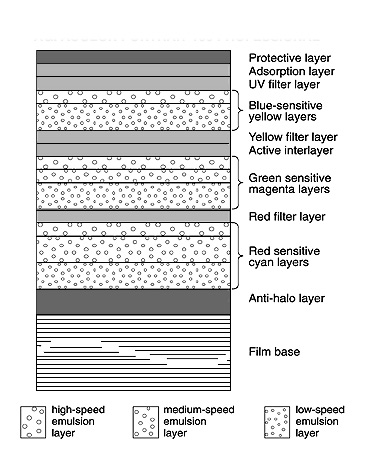
Colour film
A film that carries one or more emulsions which after processing carries a record of the colours in the original scene. This may be a negative (opposite) or a positive record.
Colour film has a more complex structure than black and white film. It can consist of many layers.
It consists of as many as nine layers with different functions:
- a protective layer of clear gelatin;
- a blue-sensitive recording layer consisting of gelatin in which silver salts and a colour coupler are embedded;
- a yellow filter layer which absorbs the blue rays of light not absorbed in the blue-sensitive layer but lets through the green and red rays;
- a green-sensitive layer;
- an interlayer of prepared gelatin which prevent dyes produced, especially during development, from migrating from their own layer and hence spoiling the image;
- a red-sensitive layer;
- an adhesion substratum;
- the base or support is usually made of cellulose triacetate or polyester ;
- an anti-halation layer which may also serve as an anti-curl layer.

Learn more about the history of colour in film in this web resource developed by Barbara Flueckiger, professor at the Institute of Cinema Studies, University of Zurich.
FIAF, 1986, Preservation and Restoration of Moving Images and Sound, Federation Internationale des Archives du Film, FIAF, Brussels, Belgium
The National Film and Sound Archive of Australia acknowledges Australia’s Aboriginal and Torres Strait Islander peoples as the Traditional Custodians of the land on which we work and live and gives respect to their Elders both past and present.


